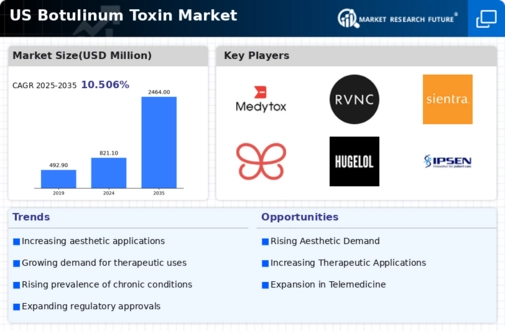Rising Geriatric Population
The increasing geriatric population in the United States is a significant driver of the botulinum toxin market. As individuals age, they often seek treatments to address age-related concerns, such as wrinkles and muscle stiffness. The demand for aesthetic procedures and therapeutic applications among older adults is expected to rise, leading to a greater consumption of botulinum toxin products. By 2025, the geriatric demographic is projected to account for a substantial portion of the market, with estimates suggesting that nearly 20% of the population will be over 65 years old. This demographic shift indicates a growing market potential for botulinum toxin, as healthcare providers cater to the needs of an aging population.
Expansion of Medical Aesthetics Industry
The expansion of the medical aesthetics industry is driving growth in the botulinum toxin market. As more individuals prioritize appearance and seek non-invasive cosmetic procedures, the demand for botulinum toxin injections is likely to increase. The rise of social media and beauty influencers has further fueled interest in aesthetic treatments, making them more accessible and desirable. In 2025, the medical aesthetics market is expected to surpass $15 billion, with botulinum toxin representing a significant share of this growth. This trend suggests that the botulinum toxin market will continue to thrive as it aligns with the broader movement towards self-care and aesthetic enhancement.
Technological Advancements in Delivery Methods
Technological innovations in the delivery methods of botulinum toxin are significantly impacting the botulinum toxin market. New techniques, such as micro-needling and advanced injection systems, enhance the precision and effectiveness of treatments. These advancements not only improve patient outcomes but also reduce the risk of complications, making botulinum toxin more appealing to both practitioners and patients. As a result, the market is experiencing a shift towards more sophisticated delivery systems, which could potentially increase the overall market size. By 2025, it is estimated that these innovations could contribute to a market growth of approximately 10%, as practitioners adopt these new technologies to enhance their service offerings.
Increased Investment in Research and Development
Increased investment in research and development (R&D) within the pharmaceutical sector is a crucial driver for the botulinum toxin market. Companies are focusing on exploring new therapeutic applications and improving existing formulations, which could lead to enhanced efficacy and safety profiles. This commitment to R&D is likely to result in the introduction of innovative products and treatment options, expanding the market's potential. By 2025, it is anticipated that R&D expenditures in the botulinum toxin sector will rise by approximately 15%, reflecting the industry's dedication to advancing treatment methodologies and meeting evolving patient needs.
Increasing Awareness of Botulinum Toxin Benefits
The growing awareness of the therapeutic and aesthetic benefits of botulinum toxin is a key driver in the botulinum toxin market. As more healthcare professionals and patients recognize its efficacy in treating various conditions, including chronic migraines and excessive sweating, the demand for botulinum toxin products is likely to rise. Educational campaigns and marketing efforts by manufacturers have contributed to this awareness, leading to an increase in prescriptions and treatments. In 2025, the market is projected to reach approximately $4 billion, reflecting a compound annual growth rate (CAGR) of around 8%. This trend indicates a robust interest in the diverse applications of botulinum toxin, further solidifying its position in the healthcare landscape.



















Leave a Comment